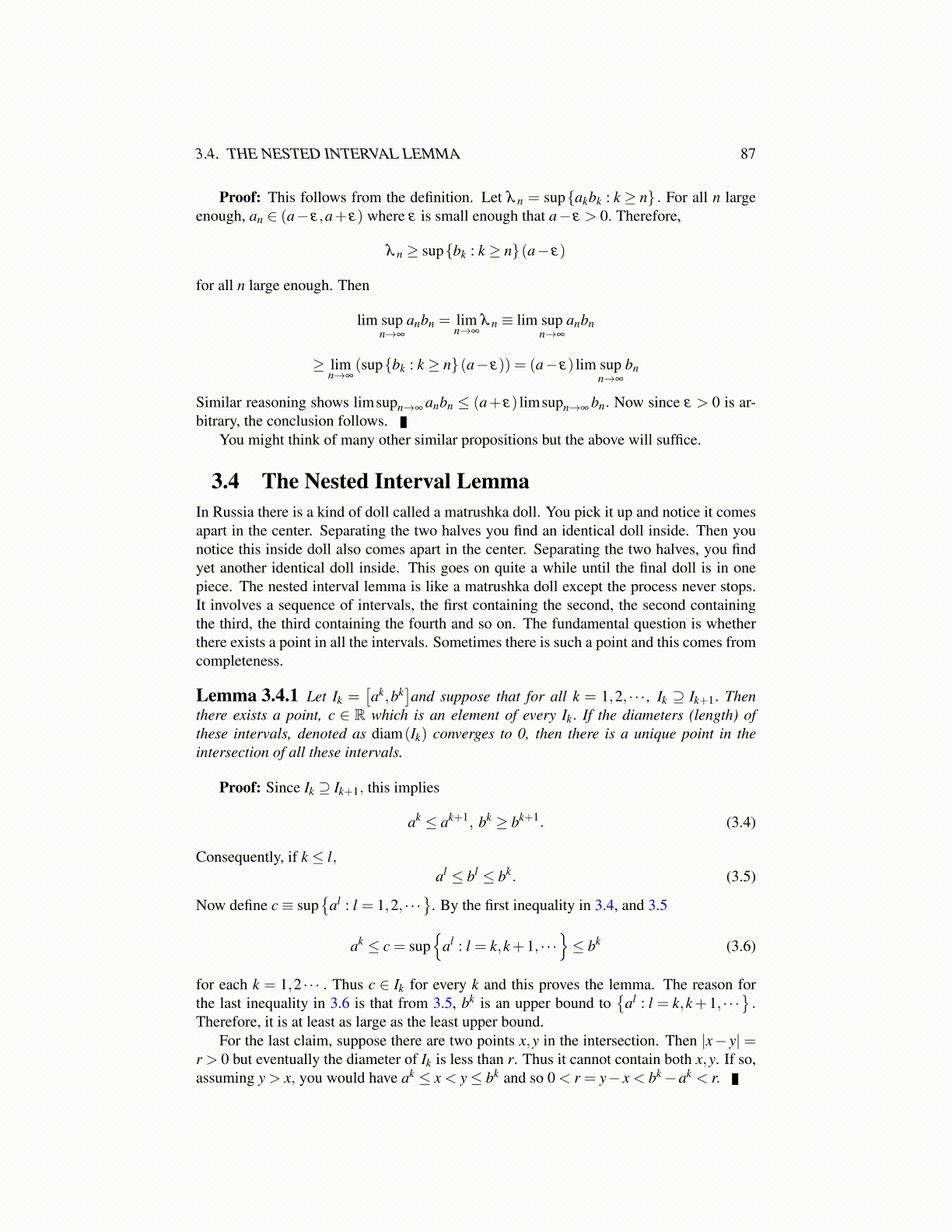
3.4. THE NESTED INTERVAL LEMMA 87
Proof: This follows from the definition. Let λ n = sup{akbk : k ≥ n} . For all n largeenough, an ∈ (a− ε,a+ ε) where ε is small enough that a− ε > 0. Therefore,
λ n ≥ sup{bk : k ≥ n}(a− ε)
for all n large enough. Then
lim supn→∞
anbn = limn→∞
λ n ≡ lim supn→∞
anbn
≥ limn→∞
(sup{bk : k ≥ n}(a− ε)) = (a− ε) lim supn→∞
bn
Similar reasoning shows limsupn→∞ anbn ≤ (a+ ε) limsupn→∞ bn. Now since ε > 0 is ar-bitrary, the conclusion follows.
You might think of many other similar propositions but the above will suffice.
3.4 The Nested Interval LemmaIn Russia there is a kind of doll called a matrushka doll. You pick it up and notice it comesapart in the center. Separating the two halves you find an identical doll inside. Then younotice this inside doll also comes apart in the center. Separating the two halves, you findyet another identical doll inside. This goes on quite a while until the final doll is in onepiece. The nested interval lemma is like a matrushka doll except the process never stops.It involves a sequence of intervals, the first containing the second, the second containingthe third, the third containing the fourth and so on. The fundamental question is whetherthere exists a point in all the intervals. Sometimes there is such a point and this comes fromcompleteness.
Lemma 3.4.1 Let Ik =[ak,bk
]and suppose that for all k = 1,2, · · · , Ik ⊇ Ik+1. Then
there exists a point, c ∈ R which is an element of every Ik. If the diameters (length) ofthese intervals, denoted as diam(Ik) converges to 0, then there is a unique point in theintersection of all these intervals.
Proof: Since Ik ⊇ Ik+1, this implies
ak ≤ ak+1, bk ≥ bk+1. (3.4)
Consequently, if k ≤ l,al ≤ bl ≤ bk. (3.5)
Now define c ≡ sup{
al : l = 1,2, · · ·}
. By the first inequality in 3.4, and 3.5
ak ≤ c = sup{
al : l = k,k+1, · · ·}≤ bk (3.6)
for each k = 1,2 · · · . Thus c ∈ Ik for every k and this proves the lemma. The reason forthe last inequality in 3.6 is that from 3.5, bk is an upper bound to
{al : l = k,k+1, · · ·
}.
Therefore, it is at least as large as the least upper bound.For the last claim, suppose there are two points x,y in the intersection. Then |x− y| =
r > 0 but eventually the diameter of Ik is less than r. Thus it cannot contain both x,y. If so,assuming y > x, you would have ak ≤ x < y ≤ bk and so 0 < r = y− x < bk −ak < r.